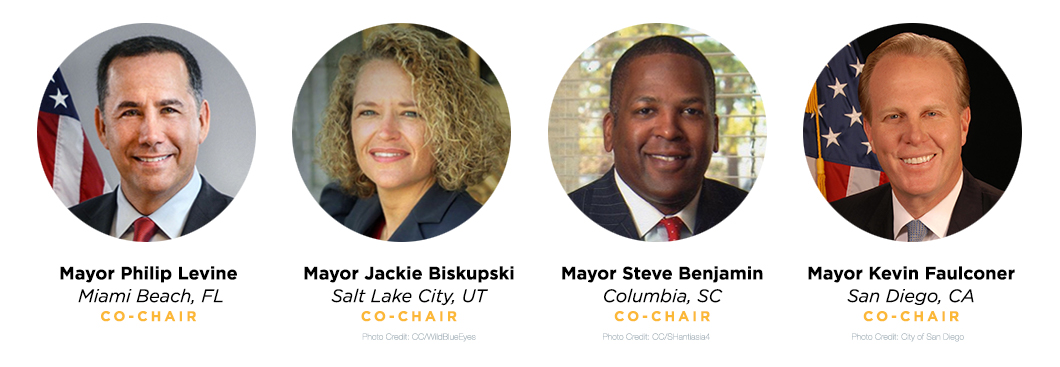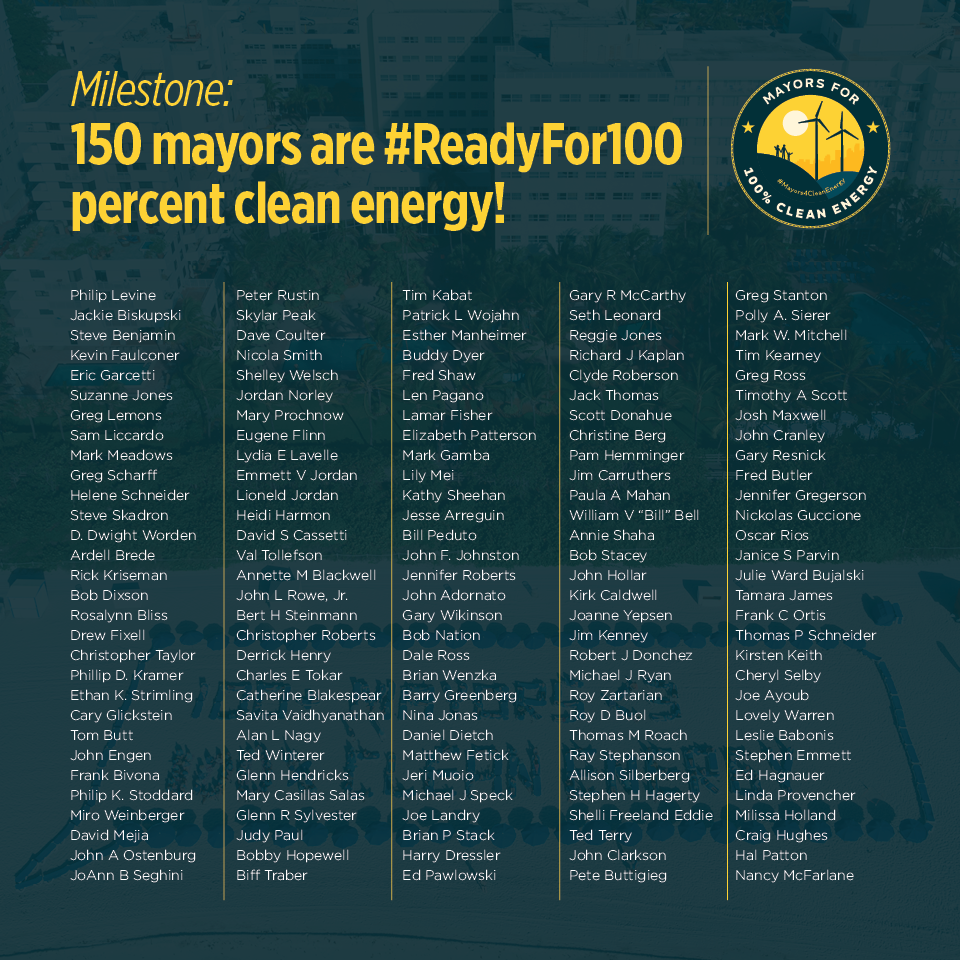Today, the Sierra Club’s Mayors For 100% Clean Energy initiative reached a major milestone: 150 mayors from across the country have signed onto the campaign and pledged to power their communities with 100 percent clean, renewable energy. Civic leaders from across the country are stepping up to make it known that they care about the health of their residents and the strength of their local economy by advocating for 100 percent clean, renewable energy.
The Mayors For 100% Clean Energy movement reached this milestone with the endorsement of Raleigh, North Carolina Mayor Nancy McFarlane. Mayor McFarlane’s endorsement marks the eighth state capital and eleventh city with a population greater than 250,000 to join the initiative. In her pledge, Mayor McFarlane said: “Cities must continue to take a leadership role in shaping a 21st-century clean energy economy if we're going to keep our economies strong and our communities healthy.” All 150 mayors are helping to make this goal a nationwide reality by advancing a 100 percent renewable energy vision in each of their communities.

Mayors in 33 states and all regions of the country are a part of the initiative. California and Florida, with 29 and 26 mayoral endorsements respectively, are leading the charge toward entirely renewable communities. Mayors from Los Angeles, Phoenix, Honolulu, and Charlotte are bringing this initiative to the nation’s biggest cities while small communities such as Abita Springs, Louisiana are also demonstrating clean energy leadership. Mayors for 100% Clean Energy is spreading far and wide and represents the interest of all Americans.
The numbers behind the Mayors for 100% Clean Energy movement substantiate that local action is the way forward. The 150 cities represented by these mayoral endorsements account for five percent of the entire nation’s electricity usage. Transitioning all 150 communities to 100 percent renewables would shift 150 million megawatt hours of energy from fossil fuels to clean energy sources. This would reduce greenhouse gas pollution in the United States by up to 60 million metric tons of carbon dioxide, equivalent to taking 12.5 million cars off the road.
In a time of federal inaction, cities represent a major opportunity for action. Communities across the country can work to better the lives of their own residents, while together make national progress in cleaning our air and reducing pollution. Mayors across the country are now speaking out and sharing this vision with their constituents.
In Rochester, New York, Mayor Lovely Warren highlights that savings that come with this transition: “We envision a plan that brings low cost renewable energy to all residents and small businesses.” Clean, renewable energy boosts the economy while also powering new jobs, and cities are recognizing this as they look toward the future.
Pittsburgh Mayor Bill Peduto is connecting his city to the broader movement: “Cities can help lead the transition away from dirty fuels to renewable energy, but it will require boldness and ambition to get it done. I’m proud to stand with my fellow Mayors for 100% Clean Energy to call for a transition to 100 percent clean and renewable energy in my community.”
Mayor Steve Benjamin, co-chair of Mayors for 100% Clean Energy and the mayor of Columbia, South Carolina, has this to say: "It’s up to us as leaders to creatively implement clean energy solutions for our cities across the nation. It’s not merely an option now; it’s imperative. Cities and mayors can lead the transition away from fossil fuels to 100 percent clean and renewable energy."
Another co-chair, Mayor Jackie Biskupski of Salt Lake City, agrees: “Cities must adapt to cope with the threats of climate change, and that’s also why we must take action to mitigate them. Salt Lake City has set the ambitious but achievable goals of generating 100 percent of the community’s electricity supply from renewable energy by 2032, followed by an 80 percent reduction in community greenhouse gas emissions by 2040. We are taking action to achieve these goals and I am honored to join mayors from across our nation to lead the transition to clean, renewable energy."

The Mayors for 100% Clean Energy initiative is co-chaired by Mayor Philip Levine of Miami Beach, Mayor Jackie Biskupski of Salt Lake City, Mayor Kevin Faulconer of San Diego, and Mayor Stephen K. Benjamin of Columbia, South Carolina.
In June, the United States Conference of Mayors, representing over 1,400 cities, adopted a historic resolution establishing support for the 100 percent clean and renewable energy goal in all member cities nationwide. The Mayors for 100% Clean Energy initiative was integral in championing this resolution.
Mayoral endorsements of 100 percent renewable energy are leading to ambitious action in municipalities across the United States. In St. Petersburg, Florida, for example, the Mayors for 100% Clean Energy endorsement preceded a formal commitment to achieving 100 percent clean, renewable energy citywide.
Thank you to our partner organizations who have worked alongside Sierra Club's Ready For 100 Campaign on this initiative including Local Progress, Climate Parents, VICE Impact, and Participant Media.
For more, watch these videos:
Mayors for 100% Clean Energy co-chair Steve Benjamin of Columbia, South Carolina champions the initiative in a city press conference
Mayor Rick Kriseman of St. Petersburg, Florida highlights what this initiative means to his city and for the nation at the U.S. Conference of Mayors
NowThis News captures the momentum that the initiative is gaining despite a lack of federal leadership
Methodology description: City commitments are assumed to lead to new, additional procurement of renewable energy. Electricity consumption estimates (2013) for each city were taken from the NREL’s State and Local Energy Data (SLED) tool to help estimate potential additional renewable energy generated, while also taking into account existing wind and solar electricity generation and legislated renewable portfolio standards. The emissions reduction potential of this additional renewable energy generation was estimated using state-specific emissions factors for non-zero marginal cost electricity, derived from EIA electric power sector carbon dioxide emissions (2014 reported and 2016 estimated) and net generation datasets. New renewable energy capacity was calculated using state-specific wind energy capacity factors. The car analogy was taken from a measurement by the Environmental Protection Agency that an average passenger car emits 4.7 metric tons of carbon dioxide annually.
